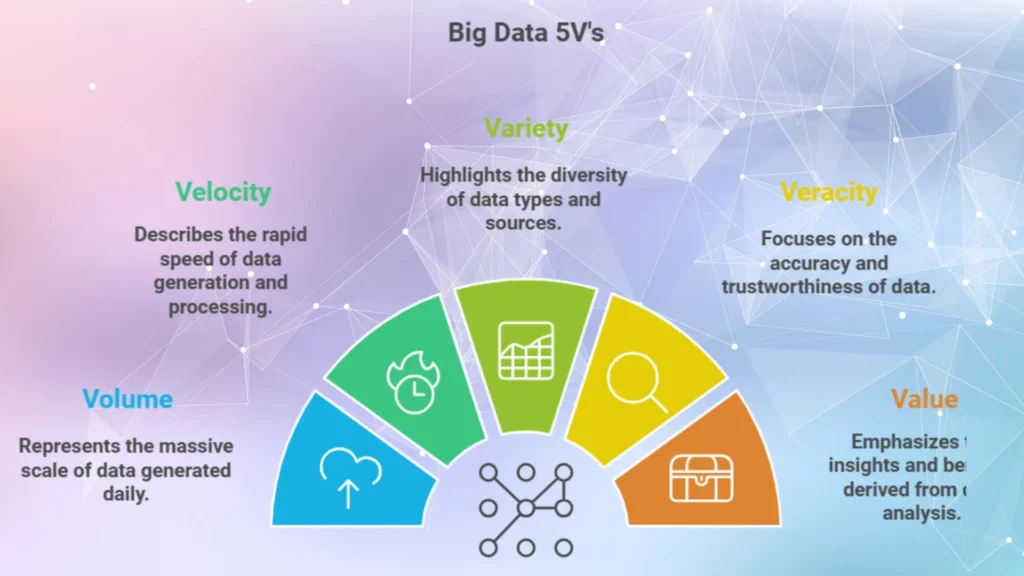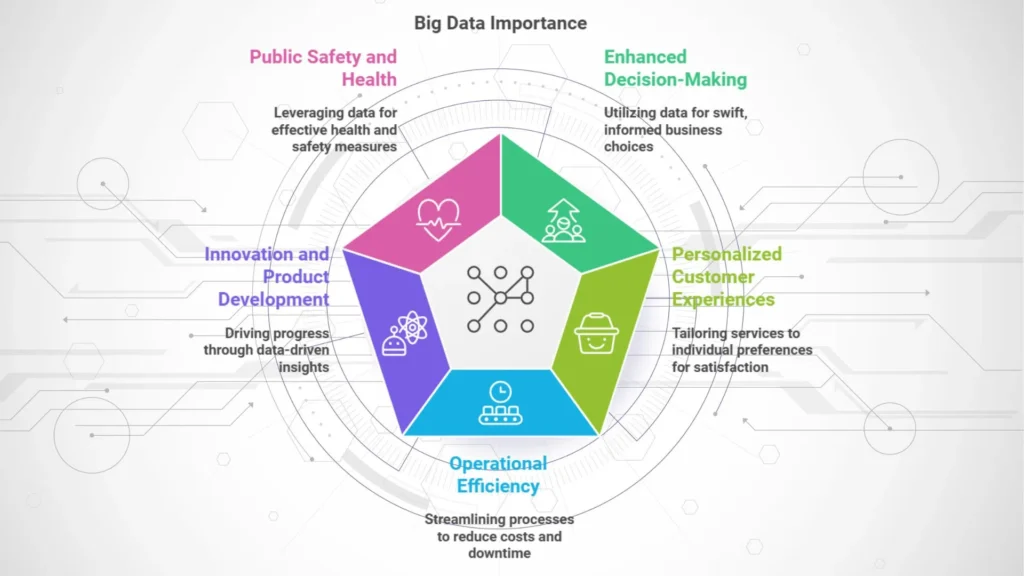In this highly modern world, data has become a important asset for businesses, governments and individuals. But as the volume of data generated continues to grow exponentially, the traditional data processing techniques can’t handle them. The term ‘big data’ has emerged to describe this large and complex datasets.
This guide studies the essentials of big data, exploring what is big data and its core characteristics, significance and real world applications with related terms like data analytics and data science.
What is Big Data?
Big Data refers to the massive volumes of structured, semi structured and unstructured data collected from various sources, processed and analyzed to reveal patterns, trends and associations. The information derived from big data is used to drive decision making, optimize operations and promote innovation.
The defining feature of big data is not just its size. It is also how data is processed and utilized. Today’s digital economy produces data from multiple sources: social media posts, online transactions, sensors, GPS systems, IoT devices and much more. This data is not simply large in volume; it comes in different formats, at different speeds and with varying levels of reliability.

Five Key Characteristics of Big Data: The 5 V’s
Big data is generally defined by five key characteristics, known as the “5 V’s”: Volume, Velocity, Variety, Veracity and Value. Each plays a critical role in understanding the scope and complexity of big data.
1. Volume
– Definition: The scale of data, often measured in terabytes, petabytes or even exabytes.
– Example: Social media giants like Facebook and X (formerly Twitter) generate hundreds of terabytes of data daily.
– Significance: Businesses must use scalable storage solutions and cloud services to handle these massive volumes efficiently.
2. Velocity
– Definition: The speed at which data is generated, collected and processed.
– Example: In the financial sector, stock trading algorithms must process data in milliseconds to make real time decisions.
– Significance: High velocity data requires quick responses and real time analysis, which can influence industries like e-commerce, healthcare and logistics.
3. Variety
– Definition: The diversity of data types and sources, ranging from structured (databases) to unstructured (emails, videos, social media).
– Example: E-commerce platforms collect customer reviews (text), purchase records (structured data) and browsing behavior (semi-structured data).
– Significance: To gain a comprehensive understanding of customer behavior, businesses must integrate different data formats and sources.
4. Veracity
– Definition: The trustworthiness and accuracy of data.
– Example: Social media data may contain noise, inaccuracies, or biases that hamper information.
– Significance: Data veracity is important for making reliable decisions. Cleaning, validating and managing data quality is essential, especially in sectors like healthcare and finance.
5. Value
– Definition: The meaningful information and benefits derived from analyzing big data.
– Example: Amazon uses data analytics to provide personalized product recommendations, to increase customer satisfaction and sales.
– Significance: Not all data is valuable; identifying and extracting relevant data is essential for achieving a return on investment (ROI) in big data initiatives.

Why is Big Data Important?
The importance of big data lies in the actionable tips it provides, which can transform industries, optimize processes and improve results. Here is why big data matters in today’s world:
1. Enhanced Decision Making
– Real World Example: Walmart uses big data to track and predict customer buying behavior, to optimize inventory and boos sales.
– Impact: Data driven decisions reduce risk and allow businesses to act swiftly based on real time information.
2. Personalized Customer Experiences
– Real World Example: Netflix uses big data to analyze user preferences and recommend shows and movies suitable to individual tastes.
– Impact: Personalization improves user satisfaction, loyalty and engagement.
3. Operational Efficiency
– Real World Example: GE’s industrial IoT platform monitors equipment in real time, which enables predictive maintenance and reduces downtime.
– Impact: Operational costs decrease as businesses reduce waste, automate processes and anticipate issues before they occur.
4. Innovation and Product Development
– Real World Example: Tesla uses big data from autonomous vehicle sensors to improve self driving capabilities.
– Impact: Big data promotes innovation by showing trends, customer needs and areas for improvement.
5. Public Safety and Health
– Real World Example: During the COVID-19 pandemic, data analysis helped track virus spread, which enabled governments to make timely decisions.
– Impact: Big data aids in public health planning, disaster management and emergency response.

Applications of Big Data Across Industries
Big data has applications in almost every sector, driving change and adding value in unique ways. Here are some notable examples:
– Healthcare: Predictive analytics is used to forecast disease outbreaks, personalize patient treatment and improve hospital operations.
– Finance: Fraud detection algorithms analyze transaction patterns to detect suspicious activity in real time.
– Retail: E-commerce sites use big data to analyze customer purchasing behavior, optimize prices and personalize marketing.
– Transportation: Ride sharing apps like Uber rely on big data to match drivers with riders, to reduce waiting times and optimize routes.
– Manufacturing: Predictive maintenance powered by big data helps to avoid costly equipment failures.
Challenges in Managing Big Data
Although, big data offers many benefits, it also comes with its own set of challenges:
1. Data Privacy and Security:
Handling sensitive data raises privacy concerns. Industries must comply with regulations like GDPR to protect user information.
2. Data Quality:
Inaccurate or incomplete data can lead to incorrect conclusions. Ensuring high data quality is essential for reliable information.
3. Data Integration:
Integrating data from different sources and formats is complex and often requires specialized tools.
4. Infrastructure and Cost:
Storing and processing large datasets require significant investment in infrastructure and cloud services.
How to Get Started with Big Data
For businesses and individuals looking to utilize big data, here is a simple roadmap:
1. Define Your Objectives: Identify what you want to achieve with big data: whether to improve customer service, enhance product quality, or optimize supply chain.
2. Choose the Right Tools: Use platforms like Hadoop, Apache Spark or cloud services like Amazon AWS and Google BigQuery, based on your budget and needs.
3. Invest in Skilled Professionals: Data scientists, analysts and engineers are essential for collecting, cleaning, analyzing and interpreting big data.
4. Ensure Compliance: Stick to data privacy and security standards to protect sensitive information.
5. Start Small and Scale: Begin with smaller, manageable projects to demonstrate value, then expand as you gain more expertise.
Conclusion
Big data is more than a trend. It is a fundamental shift in how organizations gather and use information. By understanding big data’s characteristics and potential, businesses can make better decisions, enhance customer experiences and push innovation further.
As we move into a future where data continues to grow, those who utilize its power effectively will lead the way. Big data is complex, but the rewards are high. Start small, invest in the right tools and skills and discover the potential of data to transform your business.


Thank you for your sharing. I am worried that I lack creative ideas. It is your article that makes me full of hope. Thank you. But, I have a question, can you help me?
Thank you for your sharing. I am worried that I lack creative ideas. It is your article that makes me full of hope. Thank you.